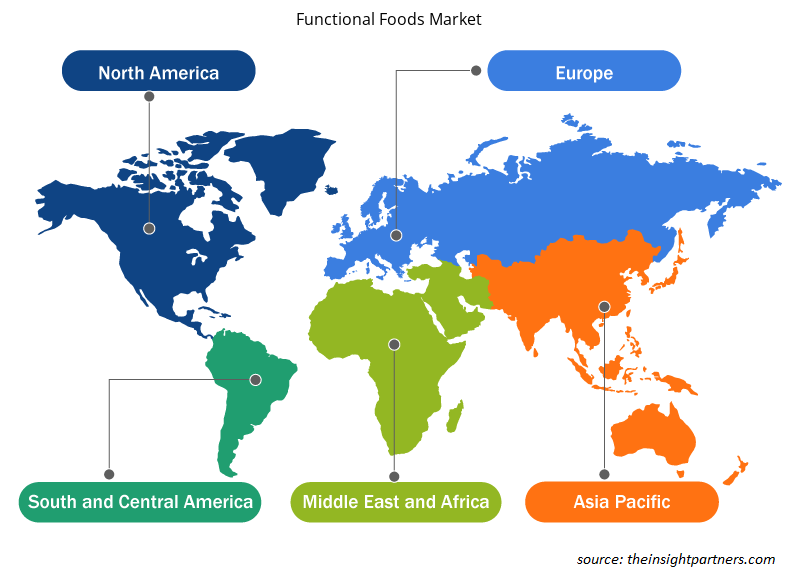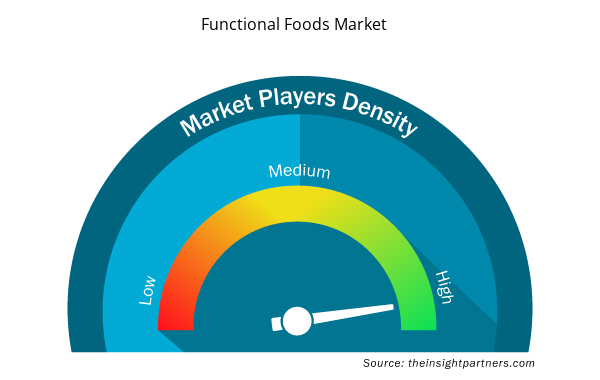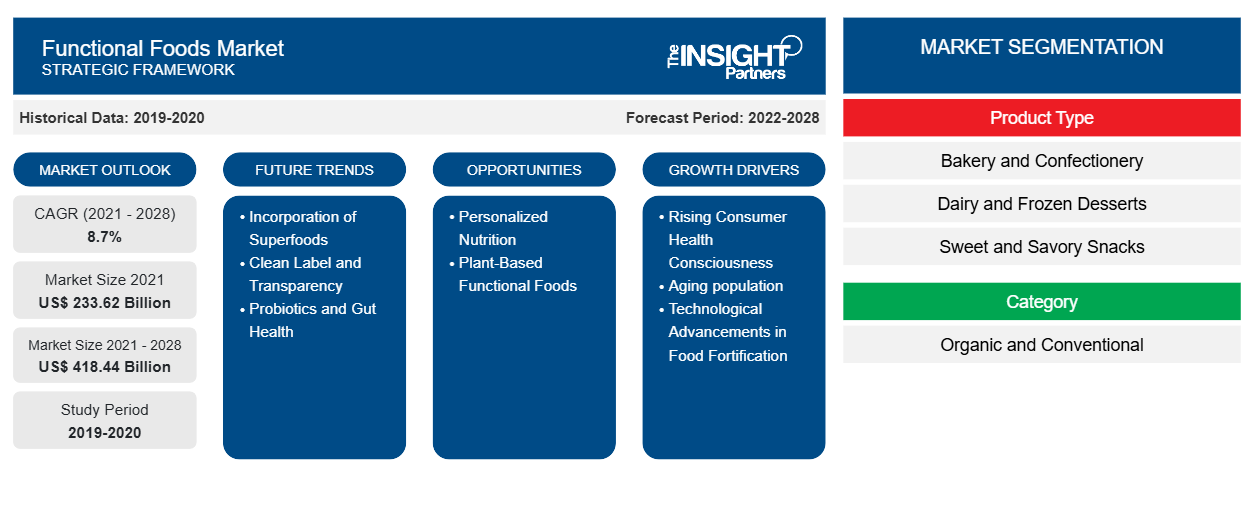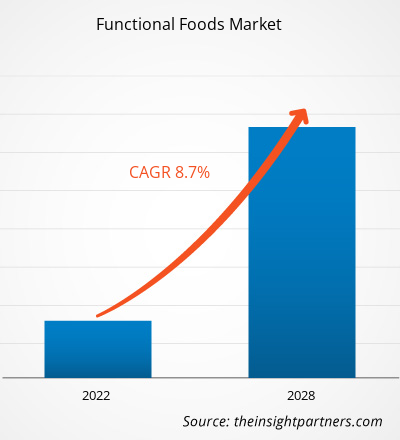2021 年功能性食品市场价值为 2336.2018 亿美元,预计到 2028 年将达到 4184.3942 亿美元。预计2021 年至 2028 年的复合年增长率为 8.7% 。
功能性食品是完整、强化、丰富或改良的食品,如果作为多样化饮食的一部分定期食用足够量,可以带来健康益处和必需营养素(例如维生素和矿物质)。功能性食品具有除典型的每日营养摄入量之外的独特健康益处,例如增强骨骼健康、控制胆固醇和改善心脏健康。此外,营养和强化食品添加剂需求的不断增长预计将推动功能性食品市场的扩张。食品制造商正在通过添加健康的添加剂(例如 omega-3 脂肪酸、纤维、维生素和矿物质)来强化他们的产品。在食品行业中添加上述添加剂的目的是提高食品的营养价值。
2020 年,亚太地区占据了全球功能性食品市场的最大份额,预计在预测期内亚太地区将大幅增长。消费者兴趣的增加以及对适当饮食和饮食习惯增强免疫力特性的更好理解是推动该地区功能性食品扩张的主要驱动力。此外,快餐摄入导致健康状况发生有害变化,并增加糖尿病和肥胖等慢性病的发病率。随着消费者对这些健康问题的认识不断提高,他们花更多的钱购买营养食品以增强整体健康,从而促进了该地区功能性食品市场的增长。
定制此报告以满足您的需求
您可以免费定制任何报告,包括本报告的部分内容、国家级分析、Excel 数据包,以及为初创企业和大学提供优惠和折扣
- 获取此报告的关键市场趋势。这个免费样品将包括数据分析,从市场趋势到估计和预测。
COVID-19 疫情对功能性食品市场的影响
由于全国范围内的封锁、企业停工和供应链中断,COVID-19 疫情影响了许多行业。疫情对功能性食品市场的影响喜忧参半。最初,由于封锁和企业停工,制造商遭受原材料和劳动力短缺的困扰,这影响了他们的生产和供应。然而,随着人们的健康意识增强,他们更喜欢有益健康的产品。功能性食品的需求量很大,因为它们有助于改善骨骼健康、控制胆固醇水平和心脏健康。此外,由于企业的积极和密集营销以及医生、营养师等健康专家的推荐,许多地区对功能性或强化食品的需求都在扩大。例如,根据 Hartman Group 基于 4 月份研究的《2020 年功能性食品和饮料报告》,31% 的消费者正在服用更多补充剂,29% 的消费者正在消费更多功能性食品/饮料,原因是疫情。此外,许多国家都接种了疫苗,政府也放宽了对制造业和贸易的限制。因此,COVID-19 疫情对功能性食品市场产生了重大影响。
市场洞察
健康零食需求不断增长
由于最近消费者行为的变化,全球零食市场正从油腻辛辣的零食转向更健康、无糖、营养丰富、低油的小包装零食。这推动了功能性食品市场的增长,因为这些食品通常富含重要营养素,包括维生素、矿物质、健康脂肪和纤维。新时代的消费者寻求营养丰富、方便携带且价格实惠的零食选择,既能满足他们的日常营养需求,又能满足他们的味蕾。例如,根据亿滋国际最近的一项调查,全球超过 59% 的成年人更喜欢全天吃多顿小餐,而不是几顿大餐。消费者对功能性零食越来越感兴趣,因为它们可以提供能量、注意力和放松,尤其是能量棒和代餐食品。此外,将个性化营养预混料加入零食中是一种有效的策略,可以加入有益的营养素,如 omega-3 脂肪酸、维生素和矿物质。功能性零食不仅可以填饱肚子,还可以提供更持久的饥饿感。这些成分为人体提供营养丰富的食物所需的基本成分。因此,人们一整天都不会感到饥饿。这一因素预计将带来几个关键趋势,这些趋势将在未来几年影响全球功能性食品市场。
类别洞察
根据类别,功能性食品市场分为有机食品和传统食品。传统食品占据了较大的市场份额。预计在预测期内,有机食品的复合年增长率将更快。消费者对有机功能性食品的需求不断增长,促使公司和种植者推广有机农业,从而推动了该细分市场的发展。制造商正在开发有机功能性食品,以满足消费者日益增长的需求。例如,美国一家包装认证有机早餐麦片制造商 Nature's Path Foods 报告称,其 Organic Optimum Power Breakfast Cereal 取得了惊人的增长。因此,由于人们的健康意识增强以及对农药有害影响的认识,对有机食品的需求增加,推动了有机功能性食品细分市场的发展。
产品类型洞察
根据产品类型,功能性食品市场细分为烘焙和糖果、乳制品和冷冻甜点、甜味和咸味小吃、早餐谷物等。预计乳制品和冷冻甜点部分将在预测期内占据全球功能性食品市场的最大市场份额。发酵乳制品具有健康益处,并扩大了功能性乳制品的范围。除此之外,牛奶提供的营养益处在控制慢性疾病方面发挥着重要作用。强化牛奶含有各种营养成分,是维生素 A 和 D 的良好来源,有助于预防儿童缺铁性贫血。它还有助于改善骨骼健康,因为强化牛奶是钙、磷和维生素 D 的良好来源。冷冻甜点基本上是通过冷冻液体、半固体和有时固体制成的甜点。功能性冷冻甜点为消费者提供了健康益处,因为它们包含各种功能性成分,如益生元和益生菌。因此,功能性冷冻甜点提供的健康益处正在推动该领域在全球功能性食品市场的增长。
分销渠道洞察
根据分销渠道,功能性食品市场细分为超市和大卖场、便利店、在线零售和其他。超市和大卖场在 2020 年占据了功能性食品市场的最大市场份额,而在线零售预计在预测期内将成为增长最快的部分。电子商务的繁荣实际上为功能性食品的在线零售提供了重大机遇。疫情爆发后,领先的制造商更积极地进入热门的电子商务平台,这些平台提供诱人的价格、强劲的销售和支持以及升级的消费者购物体验。这有望帮助在线平台成为全球增长最快的分销渠道之一。这些因素正在推动功能性食品市场在线零售渠道部分的发展。
功能性食品市场的主要参与者包括联合利华、Clif Bar & Company、Laird Superfood、雅培、达能公司、GENERAL MILLS, INC.、HILDUR、雀巢、家乐氏公司和 Good Source Foods, LLC。这些参与者致力于开发创新产品以满足新兴的消费趋势。此外,他们还参与并购、业务扩张和合作,以扩大其全球市场份额。
功能性食品
功能性食品市场区域洞察
Insight Partners 的分析师已详细解释了预测期内影响功能性食品市场的区域趋势和因素。本节还讨论了北美、欧洲、亚太地区、中东和非洲以及南美和中美洲的功能性食品市场细分和地理位置。

- 获取功能性食品市场的区域特定数据
功能性食品市场报告范围
| 报告属性 | 细节 |
|---|---|
| 2021 年市场规模 | 2336.2亿美元 |
| 2028 年市场规模 | 4184.4亿美元 |
| 全球复合年增长率(2021 - 2028) | 8.7% |
| 史料 | 2019-2020 |
| 预测期 | 2022-2028 |
| 涵盖的领域 | 按产品类型
|
| 覆盖地区和国家 | 北美
|
| 市场领导者和主要公司简介 |
|
功能性食品市场参与者密度:了解其对商业动态的影响
功能性食品市场正在快速增长,这得益于终端用户需求的不断增长,而这些需求又源于消费者偏好的不断变化、技术进步以及对产品优势的认识不断提高等因素。随着需求的增加,企业正在扩大其产品范围,进行创新以满足消费者的需求,并利用新兴趋势,从而进一步推动市场增长。
市场参与者密度是指在特定市场或行业内运营的企业或公司的分布情况。它表明在给定市场空间中,相对于其规模或总市场价值,有多少竞争对手(市场参与者)存在。
在功能性食品市场运营的主要公司有:
- 雅培实验室
- CLIF 酒吧及公司 BAR AND COMPANY
- 达能公司S.A.
- 通用磨坊公司
- 好源食品有限公司LLC
免责声明:上面列出的公司没有按照任何特定顺序排列。

- 了解功能性食品市场的主要参与者概况
报告亮点
- 功能性食品市场的渐进式行业趋势可帮助参与者制定有效的长期战略
- 发达市场和发展中市场采用的业务增长战略
- 2019 年至 2028 年功能性食品市场定量分析
- 全球功能性食品需求量估计
- 波特的五力分析说明了行业中买家和供应商的效力
- 了解竞争市场状况的最新发展
- 市场趋势和前景,以及推动和抑制功能性食品市场增长的因素
- 通过强调支撑商业利益的市场策略来协助决策过程,从而促进市场增长
- 不同节点功能性食品市场规模
- 市场详细概述和细分,以及功能性食品行业动态
- 各地区功能性食品市场规模及增长潜力
- 历史分析(2 年)、基准年、预测(7 年)及复合年增长率
- PEST 和 SWOT 分析
- 市场规模价值/数量 - 全球、区域、国家
- 行业和竞争格局
- Excel 数据集



Report Coverage
Revenue forecast, Company Analysis, Industry landscape, Growth factors, and Trends

Segment Covered
This text is related
to segments covered.

Regional Scope
North America, Europe, Asia Pacific, Middle East & Africa, South & Central America

Country Scope
This text is related
to country scope.
常见问题
Based on product type, the sweet and savory snacks segment was the fastest-growing segment in the market. The growing trend of healthy snacking across regions such as North America, Europe, and the Asia Pacific is driving the demand for savory snacks across the world. Consumers are increasingly interested in functional snacks for energy, focus, and relaxation, particularly in the form of bars and meal replacement foods.
In 2020, the dairy & frozen dessert segment accounted for the largest functional foods market share, based on product type. Consumers are increasingly consuming dairy products as it is important for building healthy bones and for maintaining a healthy weight. Yogurt is the most popular functional dairy product and is an excellent source of protein, calcium, and potassium. Also, there is a growing trend of fortification of dairy products which further drives the growth of the segment.
The increased demand for nutrient-rich foods as well as the increased prevalence of chronic diseases across the world is driving the growth of the functional foods market. Along with this, the COVID-19 pandemic has had a significant impact on consumer buying behavior and eating habits. There has been an increase in health concerns and the growing awareness regarding the consumption of natural and functional food post-pandemic which is also driving the growth of the functional foods market. Along with this, the rising trend of healthy snacking across the world is also increasing the demand for functional foods.
The market for the organic segment is expected to grow at a faster pace during the forecast period due to the increased concern regarding personal health, the environment, and animal welfare. The growing environmental concerns over the use of harmful chemicals in agriculture and farming and its harmful effects on consumers’ health have led to an increased demand for organic functional foods.
The major key players operating in the global functional foods market include Abbott Laboratories; Clif Bar and Company; Danone S.A.; General Mills, Inc; Good Source Foods, LLC; Hildur Functional Foods Pvt. Ltd; Kellogg Company; Laird Superfood; Nestlé S.A.; and Unilever Plc.
In 2020, Asia Pacific dominated the global functional foods market. The region is expected to continue its dominance during the forecast period. Trends in this market are influenced by the increased demand for nutrient-rich foods as well as the rising trend of healthy snacking across the region. The increased prevalence of chronic diseases across the region is also driving the demand for functional foods to support the healthier lifestyle of the consumers.
Trends and growth analysis reports related to Food and Beverages : READ MORE..
The List of Companies - Functional Foods Market
- ABBOTT LABORATORIES
- CLIF BAR AND COMPANY
- DANONE S.A.
- GENERAL MILLS, INC
- GOOD SOURCE FOODS, LLC
- HILDUR FUNCTIONAL FOODS PVT. LTD
- KELLOGG COMPANY
- LAIRD SUPERFOOD
- NESTLé S.A.
- UNILEVER PLC
The Insight Partners performs research in 4 major stages: Data Collection & Secondary Research, Primary Research, Data Analysis and Data Triangulation & Final Review.
- Data Collection and Secondary Research:
As a market research and consulting firm operating from a decade, we have published and advised several client across the globe. First step for any study will start with an assessment of currently available data and insights from existing reports. Further, historical and current market information is collected from Investor Presentations, Annual Reports, SEC Filings, etc., and other information related to company’s performance and market positioning are gathered from Paid Databases (Factiva, Hoovers, and Reuters) and various other publications available in public domain.
Several associations trade associates, technical forums, institutes, societies and organization are accessed to gain technical as well as market related insights through their publications such as research papers, blogs and press releases related to the studies are referred to get cues about the market. Further, white papers, journals, magazines, and other news articles published in last 3 years are scrutinized and analyzed to understand the current market trends.
- Primary Research:
The primarily interview analysis comprise of data obtained from industry participants interview and answers to survey questions gathered by in-house primary team.
For primary research, interviews are conducted with industry experts/CEOs/Marketing Managers/VPs/Subject Matter Experts from both demand and supply side to get a 360-degree view of the market. The primary team conducts several interviews based on the complexity of the markets to understand the various market trends and dynamics which makes research more credible and precise.
A typical research interview fulfils the following functions:
- Provides first-hand information on the market size, market trends, growth trends, competitive landscape, and outlook
- Validates and strengthens in-house secondary research findings
- Develops the analysis team’s expertise and market understanding
Primary research involves email interactions and telephone interviews for each market, category, segment, and sub-segment across geographies. The participants who typically take part in such a process include, but are not limited to:
- Industry participants: VPs, business development managers, market intelligence managers and national sales managers
- Outside experts: Valuation experts, research analysts and key opinion leaders specializing in the electronics and semiconductor industry.
Below is the breakup of our primary respondents by company, designation, and region:

Once we receive the confirmation from primary research sources or primary respondents, we finalize the base year market estimation and forecast the data as per the macroeconomic and microeconomic factors assessed during data collection.
- Data Analysis:
Once data is validated through both secondary as well as primary respondents, we finalize the market estimations by hypothesis formulation and factor analysis at regional and country level.
- Macro-Economic Factor Analysis:
We analyse macroeconomic indicators such the gross domestic product (GDP), increase in the demand for goods and services across industries, technological advancement, regional economic growth, governmental policies, the influence of COVID-19, PEST analysis, and other aspects. This analysis aids in setting benchmarks for various nations/regions and approximating market splits. Additionally, the general trend of the aforementioned components aid in determining the market's development possibilities.
- Country Level Data:
Various factors that are especially aligned to the country are taken into account to determine the market size for a certain area and country, including the presence of vendors, such as headquarters and offices, the country's GDP, demand patterns, and industry growth. To comprehend the market dynamics for the nation, a number of growth variables, inhibitors, application areas, and current market trends are researched. The aforementioned elements aid in determining the country's overall market's growth potential.
- Company Profile:
The “Table of Contents” is formulated by listing and analyzing more than 25 - 30 companies operating in the market ecosystem across geographies. However, we profile only 10 companies as a standard practice in our syndicate reports. These 10 companies comprise leading, emerging, and regional players. Nonetheless, our analysis is not restricted to the 10 listed companies, we also analyze other companies present in the market to develop a holistic view and understand the prevailing trends. The “Company Profiles” section in the report covers key facts, business description, products & services, financial information, SWOT analysis, and key developments. The financial information presented is extracted from the annual reports and official documents of the publicly listed companies. Upon collecting the information for the sections of respective companies, we verify them via various primary sources and then compile the data in respective company profiles. The company level information helps us in deriving the base number as well as in forecasting the market size.
- Developing Base Number:
Aggregation of sales statistics (2020-2022) and macro-economic factor, and other secondary and primary research insights are utilized to arrive at base number and related market shares for 2022. The data gaps are identified in this step and relevant market data is analyzed, collected from paid primary interviews or databases. On finalizing the base year market size, forecasts are developed on the basis of macro-economic, industry and market growth factors and company level analysis.
- Data Triangulation and Final Review:
The market findings and base year market size calculations are validated from supply as well as demand side. Demand side validations are based on macro-economic factor analysis and benchmarks for respective regions and countries. In case of supply side validations, revenues of major companies are estimated (in case not available) based on industry benchmark, approximate number of employees, product portfolio, and primary interviews revenues are gathered. Further revenue from target product/service segment is assessed to avoid overshooting of market statistics. In case of heavy deviations between supply and demand side values, all thes steps are repeated to achieve synchronization.
We follow an iterative model, wherein we share our research findings with Subject Matter Experts (SME’s) and Key Opinion Leaders (KOLs) until consensus view of the market is not formulated – this model negates any drastic deviation in the opinions of experts. Only validated and universally acceptable research findings are quoted in our reports.
We have important check points that we use to validate our research findings – which we call – data triangulation, where we validate the information, we generate from secondary sources with primary interviews and then we re-validate with our internal data bases and Subject matter experts. This comprehensive model enables us to deliver high quality, reliable data in shortest possible time.


 获取此报告的免费样本
获取此报告的免费样本